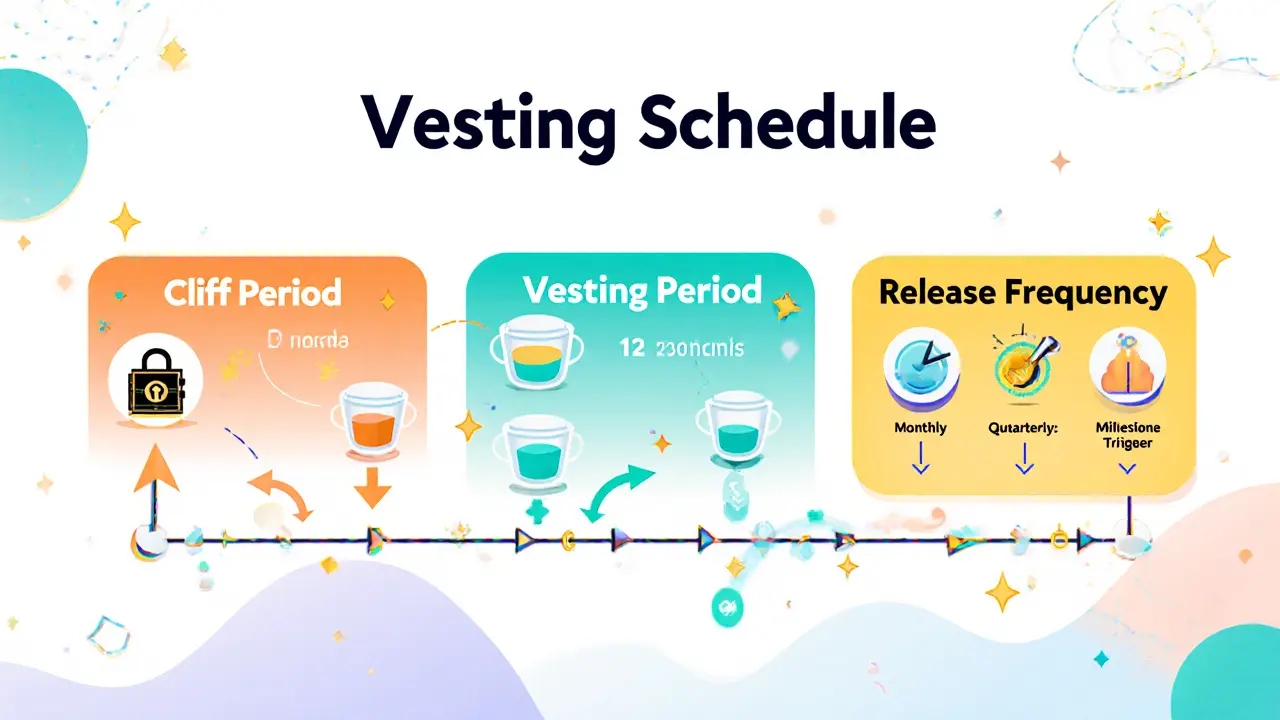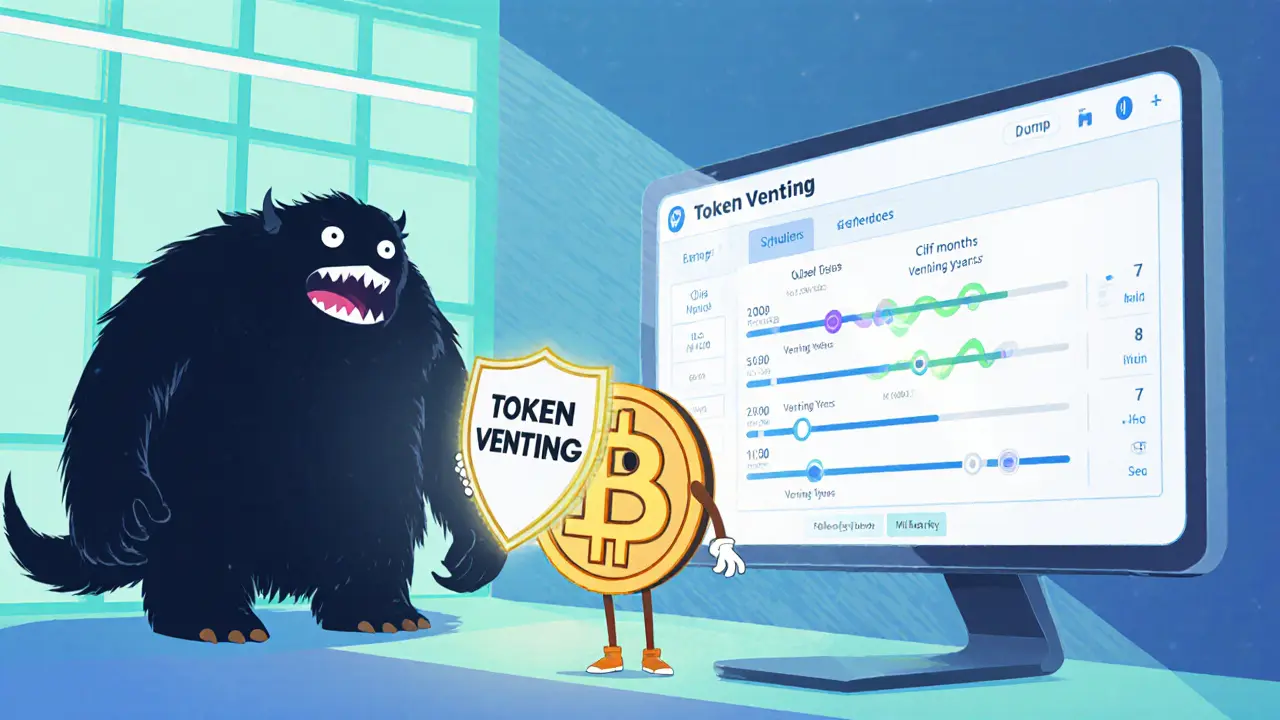Token Vesting Schedule Simulator
Vesting Schedule Summary
Total Tokens:
Cliff Period: months
Vesting Duration: years
Release Frequency:
Total Releases:
Tokens Released Per Period:
Monthly Release Schedule
| Month | Released Tokens | Cumulative Tokens | Percentage |
|---|
When a blockchain project drops a brand‑new token, the biggest fear for investors is a sudden price crash caused by massive sell‑offs. The tool that keeps that nightmare at bay is token vesting - a smart‑contract‑driven schedule that eases tokens into the market instead of dumping them all at once.
What token vesting actually is
Token vesting is a mechanism that locks up a portion of a project's tokens and releases them gradually according to a pre‑defined timetable. The process aligns the interests of founders, developers, advisors, and early investors with the long‑term health of the ecosystem. In practice, a vesting contract lives on the blockchain, runs automatically, and removes any need for a central party to decide when tokens become transferable.
Why vesting matters for token value
Tokens that are freely tradable from day one create a supply shock whenever a large holder decides to sell. This "dump" can wipe out weeks or months of price appreciation in a single block. Vesting combats that risk in three ways:
- Supply control: By staggering releases, the circulating supply grows predictably, preventing sudden spikes in available tokens.
- Incentive alignment: Team members and advisors only reap rewards if the project succeeds long enough for their tokens to vest.
- Market confidence: Investors see a transparent schedule and are less likely to panic‑sell, resulting in tighter price ranges.
Data from multiple ICO post‑mortems show that projects with a solid vesting schedule experience on average 30% less volatility during the first 12 months compared with projects that release tokens immediately.
Core components of a vesting schedule
Most vesting plans share a handful of building blocks. Understanding each piece helps you evaluate how well a project protects its token value.
- Cliff period - an initial lock‑up where no tokens are released. Typical cliffs range from 6 months to 1 year.
- Vesting period - the total duration over which the remaining tokens become transferable. Common lengths are 2‑4 years.
- Release frequency - how often a slice of tokens unlocks (monthly, quarterly, or per‑milestone).
- Milestone triggers - optional performance or development checkpoints that must be met before a release.
A textbook example looks like this: a 1‑year cliff, followed by a 3‑year linear vesting period with monthly unlocks. After the cliff, the recipient receives 25% of their allocation, then 2.08% each month for the next 36 months, reaching 100% ownership at the end of year four.
Time‑based vs. milestone‑based vesting
While many projects stick to simple time‑based schedules, others add performance conditions to tighten alignment. The table below highlights the key differences.
| Aspect | Time‑based Vesting | Milestone‑based Vesting |
|---|---|---|
| Trigger | Fixed calendar dates | Specific project milestones (e.g., mainnet launch) |
| Predictability | Highly predictable token flow | Depends on development progress; can delay releases |
| Risk mitigation | Controls supply but not performance | Aligns incentives with actual deliverables |
| Complexity | Simple smart‑contract logic | Requires oracle or governance input to confirm milestones |
| Typical use‑case | Founders, early investors | Advisors, strategic partners, community grants |

How vesting boosts token price stability
Imagine a token with 10% of its supply held by the core team. Without vesting, that 10% could be sold the moment the token lists, flooding the market and slashing the price. With a 4‑year vesting schedule, only a fraction (roughly 2-3%) becomes available each year, allowing the market to absorb supply gradually.
Two real‑world observations illustrate the effect:
- Project A, which used a 1‑year cliff and 3‑year linear vesting for its team, saw its price stay within a 15% band for the first 18 months after launch.
- Project B released all team tokens at once and experienced a 60% price drop within two weeks, followed by a prolonged recovery period.
These outcomes are not coincidences; they directly reflect the supply‑demand dynamics governed by vesting.
Implementation basics for developers
Setting up a vesting contract is straightforward on most EVM‑compatible chains. Below is a high‑level checklist that any project should run through before deploying:
- Define the tokenomics model - total supply, allocation percentages, and intended vesting ratios.
- Choose cliff length and overall vesting period based on role (e.g., founders vs. advisors).
- Select release frequency - monthly is common, but quarterly reduces gas costs.
- Decide whether to add milestone triggers; if so, identify reliable oracles or governance processes.
- Write the smart contract using a vetted template (OpenZeppelin’s TokenVesting library is a popular starting point).
- Run thorough audits - both security (to prevent re‑entrancy) and tokenomics validation (to ensure the schedule aligns with the whitepaper).
- Publish the contract address and a clear release schedule on the project’s website; transparency builds trust.
Even with a simple time‑based approach, the contract must include functions for claiming unlocked tokens, checking remaining balance, and handling emergency pauses.
Community perception and investor confidence
In crypto forums and Discord channels, a transparent vesting plan is often the first thing a skeptical investor asks about. When teams openly share the contract address and a live vesting dashboard, it signals a commitment to long‑term value creation. Conversely, projects that hide or constantly change their vesting terms tend to be labeled “pump‑and‑dump” schemes, deterring serious capital.
Surveys from 2024 showed that 78% of institutional investors rate a clear vesting schedule as a “must‑have” compliance factor before allocating funds to a new token.
Future trends in vesting design
The basic cliff‑and‑linear model is still the workhorse, but innovators are experimenting with dynamic vesting that reacts to on‑chain metrics. Examples include:
- Performance‑linked vesting that accelerates token release when daily active users cross a threshold.
- Governance‑voted adjustments that extend or shorten vesting periods based on community sentiment.
- Hybrid models that blend time‑based releases with milestone checkpoints, offering a balance of predictability and incentive alignment.
These advances keep the core principle intact - protecting token value - while giving projects more flexibility to reward contributors when they truly add value.
Quick checklist for investors evaluating a token’s vesting plan
- Is there a documented cliff period? How long is it?
- What is the total vesting duration for the team and advisors?
- How frequently do tokens unlock - monthly, quarterly, or per milestone?
- Are the vesting contracts audited and publicly viewable?
- Does the schedule align with the project's roadmap and revenue timeline?
If the answers check out, the token is far less likely to suffer a sudden price crash.

Frequently Asked Questions
What is the difference between a cliff and a vesting period?
The cliff is the initial lock‑up phase where no tokens are released. Once the cliff ends, the vesting period begins and tokens start to unlock according to the schedule.
Can token vesting be reversed if a team member leaves early?
Yes. Many contracts include a “reverse vesting” clause that re‑claims unvested tokens if the recipient departs before the cliff or during the vesting period.
How do milestone‑based vesting contracts verify that a milestone is met?
Typically an oracle or on‑chain governance vote confirms the milestone. The contract then triggers the token release automatically.
Do investors receive vested tokens, or are they only for team members?
Both can be vested. Early investors often have a shorter cliff and faster release schedule, while team members usually face longer cliffs to ensure commitment.
Is token vesting required by law?
No universal law mandates vesting, but securities regulators in several jurisdictions view transparent vesting as a good governance practice, especially for token sales that qualify as securities.


Cynthia Rice
Vesting is the unseen hand that steadies the market, a quiet promise that tomorrow's value will not be shattered by today's greed.
Without it, tokens become fireworks, bright and fleeting.